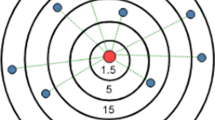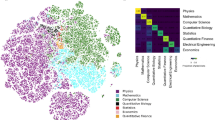Abstract
This study proposes a quantitative analysis of researcher mobility (i.e. transfer from one institution to another) and collaborative networks on the basis of author background data extracted from biographical notes in scientific articles to identify connections that are not revealed via simple co-authorship analysis. Using a top-ranked journal in the field of computer vision, we create a layered network that describes various aspects of author backgrounds, demonstrating a geographical distribution of institutions. We classify networks according to various dimensions including authors, institutions and countries. The results of the quantitative analysis indicate that mobility networks extend beyond the typical collaborative networks describing institutional and international relationships. We also discuss sectoral collaboration considering the mobility networks. Our findings indicate a limitation of collaborative analysis based on bibliometric data and the importance of tracing researcher mobility within potential networks to identify the true nature of scientific collaboration.








Similar content being viewed by others
References
Barabási, A.-L., & Albert, R. (1999). Emergence of scaling in random networks. Science, 286, 509–512.
Barabási, A.-L., Albert, R., & Jeong, H. (2000). Scale-free characteristics of random networks: The topology of the world-wide web. Physica A, 284, 69–77.
Barabási, A.-L., Jeong, H. N., Néda, Z., Ravasz, E., Schubert, A., & Vicsek, T. (2002). Evolution of the social network of scientific collaborations. Physica A, 411, 590–614.
Barjak, F., & Robinson, S. (2007). International collaboration, mobility and team diversity in the life sciences: Impact on research performance. Social Geography Discussion, 3, 121–157.
Borgatti, S. P. (2005). Centrality and network flow. Social Networks, 27, 55–71.
Bozeman, B., & Corley, E. (2004). Scientists’ collaboration strategies: Implications for scientific and technical human capital. Research Policy, 33, 599–616.
Calero, C., Buter, B., Valdés, C. C., & Noyons, E. (2006). How to identify research groups using publication analysis: An example in the field of nanotechnology. Scientometrics, 66, 365–376.
Calero, C., van Leeuwen, T. N., & Tijssen, R. J. W. (2007). Research cooperation within the bio-pharmaceutical industry: Network analyses of co-publications within and between firms. Scientometrics, 71, 87–99.
Cardillo, A., Scellato, S., & Latora, V. (2006). A topological analysis of scientific coatuhtorship networks. Physica A, 372, 333–339.
D’Este, P., & Patel, P. (2007). University-industry linkages in the UK: What are the factors underlying the variety of interactions with industry. Research Policy, 36, 1295–1313.
Etzkowitz, H., & Leydesdorff, L. (2000). The dynamics of innovation: From national system and “mode 2” to a triple helix of university-industry-government relations. Research Policy, 29, 109–123.
Fontana, R., Geuna, A., & Matt, M. (2005). Factors affecting university-inductry R & D projects: The importance of searching, screening and signalling. Research Policy, 35, 309–323.
Freeman, L. C. (1977). A set of measures of centrality based on betweenness. Sociometry, 40, 35–41.
Gay, B., & Dousset, B. (2005). Innovation and network structural dynamics: Study of the alliance network of a major sector of the biotechnology industry. Research Policy, 34, 1457–1475.
Goh, K.-I., Oh, E., Jeong, H., Kahng, B., & Kim, D. (2002). Classification of scale-free networks. Proceedings of National Academy of Sciences, 99, 12583–12588.
Guimerà, R., Uzzi, B., Spiro, J., & Amaral, L. A. N. (2005). Team assembly mechanisms determine collaboration network structure and team performance. Science, 308, 697–702.
Jonkers, K., & Tijssen, R. (2007). Chinese researchers returning home: Impacts of international mobility on research collaboration and scientific productivity. Scientometrics, 77(2), 309–333.
Laudel, G. (2002). Collaboration and reward. Research Evaluation, 11, 3–15.
Leydesdorff, L., Dolfsma, W., & van der Panne, G. (2006). Measuring the knowledge base of an economy in terms of triple-helix relations among ‘technology, organization, and territory’. Research Policy, 35, 181–199.
Newman, M. E. J. (2001). The structure of scientific collaboration networks. Proceedings of National Academy of Sciences, 98(2), 404–409.
Newman, M. E. J. (2004). Coauthorship networks and patterns of scientific collaboration. Proceedings of National Academy of Sciences, 101(suppli.1), 5200–5205.
Otte, E., & Rousseau, R. (2002). Social network analysis: A powerful strategy, also for the information sciences. Journal of Information Science, 28, 441–453.
Palla, G., Barabási, A.-L., & Vicsek, T. (2007). Quantifying social group evolution. Nature, 446, 664–667.
Perianes-Rodríguez, A., Olmeda-Gómez, C., & Moya-Anegón, F. (2010). Detecting, identifying and visualizing research groups in co-authorship networks. Scientrometrics, 82, 307–319.
Tijssen, R. J. W. (2001). Global and domestic utilization of industrial relevant science: Patent citation analysis of science—technology interactions and knowledge flows. Research Policy, 30, 35–54.
Tijssen, R. J. W. (2004). Is the commercialization of scientific research affecting the production of public knowledge? Global trends in the output of corporate research articles. Research Policy, 33, 709–733.
Author information
Authors and Affiliations
Corresponding author
Rights and permissions
About this article
Cite this article
Furukawa, T., Shirakawa, N. & Okuwada, K. Quantitative analysis of collaborative and mobility networks. Scientometrics 87, 451–466 (2011). https://doi.org/10.1007/s11192-011-0360-7
Received:
Published:
Issue Date:
DOI: https://doi.org/10.1007/s11192-011-0360-7




